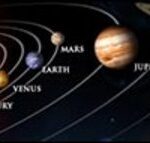Are you looking for kid’s facts about the planet Uranus? Are you working on a science report about Uranus? Or, are you a home school parent planning a lesson on the solar system? Just needing some random information about the planet Uranus? Below are a few fun facts for kids about Uranus.
Uranus was discovered by a music teacher.
In 1781, William Herschel noticed Uranus with his telescope. He was a music teacher and conductor in England. He tracked its movement, and learned it was a planet. (Planets move across the sky, but stars do not.)
Originally, Herschell named it “George’s Star” after King George III. However, later astronomers chose to name it after a mythological Roman god, to be like all of the other planets. (The ancient Romans named the planets they could see after their fictitious gods.)
Uranus cannot be seen without a telescope.
You need a telescope to be able to see Uranus. However, you can see some other planets such as Mercury, Venus and Mars without a telescope.
If a space ship made it to Uranus, it probably would not have a place to land.
Uranus does not have a hard, rocky surface like Earth does. Scientists call it a “gas giant.” It consists of mostly liquid and gas. There is also a lot of ice and “cold mush.” .However, some astronomers believe that Uranus’s core consists of rock and metal. The atmosphere consists of about 83 percent hydrogen, 15 percent helium and 2 percent methane.
Uranus is the seventh planet from the sun.
Uranus is very far away from the sun. It is much, much farther away than the Earth is from the sun. It is about 1.8 billion miles from the sun. That is approximately 19 times as far from the sun as the Earth is.
It takes Uranus about 84 Earth years to orbit around the sun.
All planets move around the sun. This is known as orbiting. It takes Uranus about 84 Earth years to orbit around the sun. That means one year on Uranus is equal to 84 Earth years.
Uranus spins on its side.
All of the planets, including the Earth, are constantly spinning around on an imaginary axis. However, Uranus is unlike the other planets. It spins on its side, kind of like a top that fell on its side and keep spinning. Astronomers do not know why Uranus is tilted. It is possible it had a collision with a large object, such as another planet.
Because it is tilted, one pole of the planet is in daylight for 42 years, and the other pole is in 42 years of darkness. Then, as the planet orbits, the poles switch and the light one is dark all the time.
Uranus is a very cloudy planet.
Uranus is covered with clouds that consist of ice and gases. Astronomers have noticed that new large clouds are forming on the planet. They move extremely fast and are rapidly changing shape.
Uranus is a very cold planet.
Because Uranus is so far from the soon, it is a very cold planet. It is very cold in Uranus’s clouds. The temperature there is approximately -357 degree Fahrenheit.
Uranus is a large planet.
If Uranus were hollow, about fifty planet Earths would fit inside. The mass of Uranus is equal to about 14 Earths.
Uranus has an aquamarine color.
Uranus gives a glow that is an aquamarine color. Scientists believe this happens because of the methane gas in the atmosphere. When you view Uranus from a telescope at home, it looks like a little green pea.
Uranus has at least 27 moons.
Astronomers have discovered that Uranus has 27 moons. Several of them have been named after characters from Shakespeare’s plays. The moon that is closest to Uranus is named Miranda. It consists of mostly ice and rock. It also has very deep canyons, one that is 12 times deeper than the Grand Canyon.
Uranus has at least 13 rings.
Scientists have discovered that Uranus has at least 13 rings. They consist of mostly dust and rocks. These rings were not discovered until 1977, about 22 years after Uranus was found. Some of them weren’t discovered until as late as 2005 by the Hubble Space Telescope.
These are just a few random facts about the planet Uranus. Wanting to learn more about the other planets? Please read “Planet Jupiter Facts for Kids” and “Interesting Facts for Kids About the Planet Neptune.” You also might read “Facts for Kids About the Planet Mercury.” Happy Learning!
Sources:
Uranus by Elaine Landau
Our Solar System by Seymour Simon
11 Planets: A New View of the Solar System by David A. Aguilar





